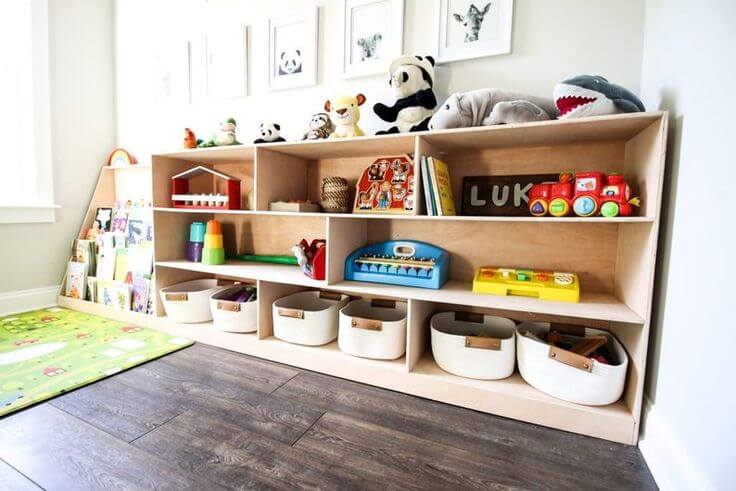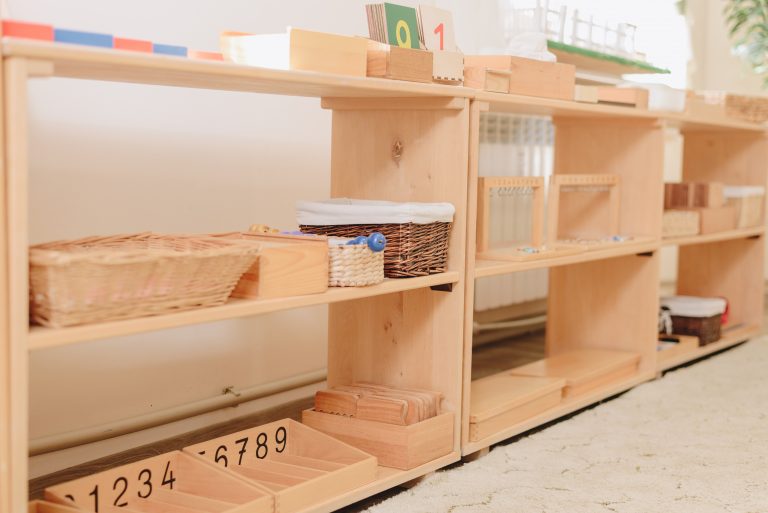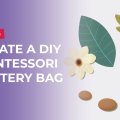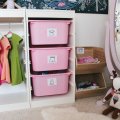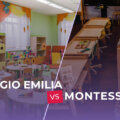Why should I create a mystery bag for my child?
By creating a mystery bag, you are providing your child with an opportunity to develop their stereognostic sense, as well as their language and sorting skills. It’s a simple and effective Montessori activity that can be easily adapted to suit your child’s interests and abilities.
What ages should I introduce a Montessori mystery bag?
I love the mystery bag as it’s such a versatile Montessori material that can be used with children of different ages and stages of development!
Generally, children between the ages of 2 and 6 years old will benefit the most from exploring a mystery bag.
At this stage, children are developing their sense of touch and hand-eye coordination, and are naturally curious about the world around them. However, older children and even adults can also enjoy the challenge and sensory stimulation of a mystery bag.
How to create your own DIY mystery bag
What you’ll need – materials:
- a small fabric bag or pouch
- A variety of small, everyday objects
- A blindfold (optional)
How to create and present this Montessori activity:
- Start by gathering a variety of small objects that are safe for your child to touch and explore. Choose objects with different textures, shapes, and sizes.
- Place the objects inside the fabric bag or pouch.
- If your child is new to the activity, you may want to introduce it without a blindfold at first. Encourage them to reach into the bag and explore the objects with their hands. You can guide them to use their sense of touch to guess what each object is.
- Once your child becomes comfortable with the activity, you can introduce a blindfold to challenge their stereognostic sense. Blindfold your child and ask them to reach into the bag and guess what each object is based on touch alone.
- You can also encourage your child to use their language skills by describing each object as they explore it, or ask them to sort the objects by texture or shape.
Handy Tips:
- Start with a small number of objects and gradually increase as your child becomes more familiar with the activity.
- Make sure the objects you choose are safe and age-appropriate for your child.
- Encourage your child to use both hands to explore the objects and switch between them.
- Use the mystery bag activity as a fun game that you can play with your child or as a quiet time activity they can do on their own.

What objects should I put in the mystery bag?
Remember to choose objects that are safe and age-appropriate for your child, and that offer a variety of textures, shapes, and sizes to challenge their sense of touch. Here’s a few suggestions you can try!
- A small ball
- A wooden block
- A smooth stone
- A small plush toy
- A plastic figurine
- A feather
- A seashell
- A small metal spoon or fork
- A piece of crinkly paper
- A bumpy rubber ball
- A key or keyring
- A pinecone, leaf or flower
- A small plastic container with a lid
- A textured fabric swatch
- A wooden clothespin
You could also creating themed mystery bags, aligned to a season, holiday or another topic of interest to your child!
- Nature-themed mystery bag – Fill the bag with objects from nature, such as rocks, shells, feathers, leaves, and flowers.
- Spring Garden-themed mystery bag – Fill the bag with objects that are inspired by a spring garden, such as a small flower pot, a seed packet, a gardening glove, a butterfly-shaped cookie cutter, and a flower-shaped soap. This theme is a great opportunity to encourage children to explore nature and learn about the plant life cycle.
- Texture-themed mystery bag – Fill the bag with objects that have interesting textures, such as a fuzzy pom-pom, a bumpy rubber ball, a silky ribbon, a rough sandpaper square, and a smooth stone.
- Household-themed mystery bag – Fill the bag with objects from around the house, such as a key, a spoon, a button, a clothespin, and a piece of fabric.
- Christmas Tree-themed mystery bag – Fill the bag with objects related to a Christmas tree, such as a miniature ornament, a small string of lights, a star topper, a tiny gift, and a candy cane.
Can I buy a pre-made mystery bag instead of making one?
You sure can! If you’re looking to buy a premade mystery bag, there are a few options available. I especially love the bags of mini geometric solids. Ticks off two toys in one. Etsy has a range available, as well as Amazon and Montessori Services.
Fancy Nancy Montessori offers a pre-made set including a drawstring bag and activity mat crafted with premium 100% cotton. The bag comes with a special inner lining that lets your little ones focus on exploring different textures, without getting distracted by pesky seams or strings. They also offer custom sizes or colors to match your child’s preferences.
Fabric Stories Co offers a set that comes with 10 geometric solids (3D wooden shapes) and 10 corresponding flash cards, making it a great tool for developing tactile and visual recognition skills.
Store all the shapes in the included blue bag and take turns pulling out a flash card, then attempting to identify the required shape by touch alone.
When it comes to sensorial activities, using a blindfold can help a child enhance their senses of taste, touch, smell, or sound. If you want to DIY your bag contents, this blindfold and bag combo is a good start. The blindfold comes with peek-proof eyelet ruffles around the bottom, and a lightweight flannel lining for comfort.
Montessori Outlet’s Mystery Bag for toddlers and preschoolers contains various familiar household objects, perfect for little hands to explore and learn. By using familiar items, your child can rely on their prior knowledge and experiences to help them identify the objects in the bag. Using familiar items can also help to promote language development, as your child can use their words to describe the objects they are feeling!
This 3D Shapes Guess Game comes with a variety of shapes, including a cube, cuboid, triangular prism, cylinder, square pyramid, triangular pyramid, cone, ovoid, ellipsoid, and sphere. Made of durable beech wood, it can withstand years of playtime. The shape name cards help kids learn the names of the geometric solids while touching and feeling them.
The Bottom Line
Creating a DIY Montessori mystery bag can be a fun and educational activity that promotes sensory exploration, hand-eye coordination, and language development in a safe and age-appropriate way.
By following the simple steps and handy tips provided in this article, you can easily make a mystery bag at home and customize it to suit your child’s interests and abilities. Whether you choose to buy a pre-made bag or make one yourself, I hope this article has helped you to feel inspired to try this engaging Montessori activity with my child. H
appy exploring!







